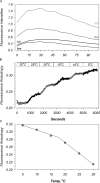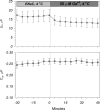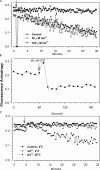ENaC-membrane interactions: regulation of channel activity by membrane order
- PMID: 15148329
- PMCID: PMC2234566
- DOI: 10.1085/jgp.200308983
ENaC-membrane interactions: regulation of channel activity by membrane order
Abstract
Recently, it was reported that the epithelial Na+ channel (ENaC) is regulated by temperature (Askwith, C.C., C.J. Benson, M.J. Welsh, and P.M. Snyder. 2001. Proc. Natl. Acad. Sci. USA. 98:6459-6463). As these changes of temperature affect membrane lipid order and lipid-protein interactions, we tested the hypothesis that ENaC activity can be modulated by membrane lipid interactions. Two approaches were used to modulate membrane anisotropy, a lipid order-dependent parameter. The nonpharmacological approach used temperature changes, while the pharmacological one used chlorpromazine (CPZ), an agent known to decrease membrane order, and Gd+3. Experiments used Xenopus oocytes expressing human ENaC. Methods of impedance analysis were used to determine whether the effects of changing lipid order indirectly altered ENaC conductance via changes of membrane area. These data were further corroborated with quantitative morphology on micrographs from oocytes membranes studied via electron microscopy. We report biphasic effects of cooling (stimulation followed by inhibition) on hENaC conductance. These effects were relatively slow (minutes) and were delayed from the actual bath temperature changes. Peak stimulation occurred at a calculated Tmax of 15.2. At temperatures below Tmax, ENaC conductance was inhibited with cooling. The effects of temperature on gNa were distinct from those observed on ion channels endogenous to Xenopus oocytes, where the membrane conductance decreased monoexponentially with temperature (t = 6.2 degrees C). Similar effects were also observed in oocytes with reduced intra- and extracellular [Na+], thereby ruling out effects of self or feedback inhibition. Addition of CPZ or the mechanosensitive channel blocker, Gd+3, caused inhibition of ENaC. The effects of Gd+3 were also attributed to its ability to partition into the outer membrane leaflet and to decrease anisotropy. None of the effects of temperature, CPZ, or Gd+3 were accompanied by changes of membrane area, indicating the likely absence of effects on channel trafficking. However, CPZ and Gd+3 altered membrane capacitance in an opposite manner to temperature, consistent with effects on the membrane-dielectric properties. The reversible effects of both Gd+3 and CPZ could also be blocked by cooling and trapping these agents in the rigidified membrane, providing further evidence for their mechanism of action. Our findings demonstrate a novel regulatory mechanism of ENaC.
Figures















References
-
- Aguilella, V.M., and S.M. Bezrukov. 2001. Alamethicin channel conductance modified by lipid charge. Eur. Biophys. J. 30:233–241. - PubMed
-
- Allen, T.J., and G. Mikala. 1998. Effects of temperature on human L-type cardiac Ca2+ channels expressed in Xenopus oocytes. Pflugers Arch. 436:238–247. - PubMed
-
- Awayda, M.S., I.I. Ismailov, B.K. Berdiev, and D.J. Benos. 1995. A cloned renal epithelial Na+-channel protein displays stretch activation in planar lipid bilayers. Am. J. Physiol. 268:C1450–C1459. - PubMed
Publication types
MeSH terms
Substances
Grants and funding
LinkOut - more resources
Full Text Sources
Research Materials

